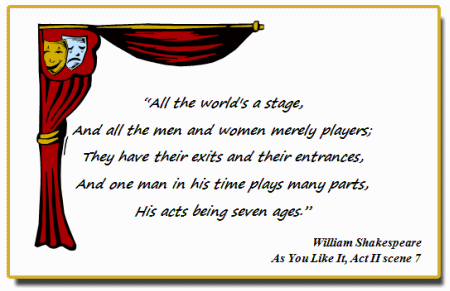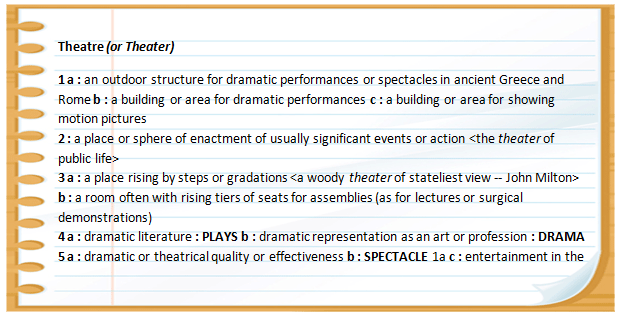Course Overview
Throughout this course, you will learn about the theatre from its origins to a modern day opening night. You will also have the opportunity to develop your own skills in lighting, set and costume design; as well as acting, directing, producing and script development. Various forms of plays will be discussed; covering a large span of time periods, targeting the relationship theatre has with society. You will also learn to develop an appreciation for theatre and skills for critical evaluation of theatrical productions. Caution: Some of the passages in this course may be sensitive to your students.
Required Materials for Introduction to Theatre I
Please print or save this document for future reference.
THE ORIGINS OF THEATRE
Unit Overview
In this unit, you will be introduced to the theatre; learn about the history, origins and study theatre as an art form. You will learn to identify different time periods throughout history and reflect on the influence that it had on theatre, as well as focus on drama in Ancient Greece and how it still contributes to theatre today.
1. Introduction
Welcome to the Introduction to Theatre I! Throughout this course, you will learn the basics of the many exciting facets of theatre. Maybe theatre is already a passion or hobby of yours or maybe this course will be your first exploration into the world of theatre. Either way, you will learn about so many contributing aspects of theatre, that hopefully you will be encouraged to further your study, understanding and appreciation for it. As you can see in the famous quote from William Shakespeare’s As You Like It, “All the world’s a stage, And all the men and women merely players.” So you see, you might know more about theatre than you think!
This course will be a fun journey through the world of theatre. You will be introduced to many new terms, concepts and exciting project work. You will want to keep a notebook or folder to help organize all of your new terms, monologues and design work for your portfolio.

Now answer questions 1 and 2.
PLEASE NOTE…Plagiarism will warrant a zero. This includes cuting-and-pasting, taking another student’s work, or copying three or more words from a published work. All submitted work MUST be your own!
2. What is Theatre? The term theatre is said to originally derive from the Greek word, theatron, meaning “to view; act of seeing.” According to
Merriam-Webster’s Collegiate Dictionary, theatre has the following five meanings:
In this course, we will be looking more closely at each of these meanings, for each has been an influence on what we know as theatre. However, our main focus will be on definition 4b, “dramatic representation as an art or profession,” which most closely relates to what we are about to study. Today, what is most commonly considered theatre is a broad range of activities including spoken drama, opera and dance culminating in a live performance in front of an audience. We will learn about the origin, purpose and execution of theatre.
 Now answer questions 3 through 5.
Now answer questions 3 through 5.
3. In the Beginning
An interesting fact about theatre, although much speculation is available, is that no one knows exactly how or why theatre originally developed. Theatre historians have been researching the topic for years without determinate evidence for its exact moment of creation. Because of this, many different conclusions have been made. One of the most popular conclusions gives us the following explanation.
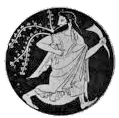 In Ancient Greece, religious festivals were held twice a year to honor Dionysus,
the Greek god of wine and fertility. During the festivities, in order to properly honor Dionysus, singing and dancing took place. This celebration morphed into presentations of myths and stories of Dionysus and other Greek gods. This was presented at the front of the stage by a chorus; which was a group of performers, who sang, danced and commented on the ongoing action. The chorus would wear masks with exaggerated expressions to convey the anticipated emotion to the audience. The members of the chorus had to be very versatile actors, singers and dancers.
In Ancient Greece, religious festivals were held twice a year to honor Dionysus,
the Greek god of wine and fertility. During the festivities, in order to properly honor Dionysus, singing and dancing took place. This celebration morphed into presentations of myths and stories of Dionysus and other Greek gods. This was presented at the front of the stage by a chorus; which was a group of performers, who sang, danced and commented on the ongoing action. The chorus would wear masks with exaggerated expressions to convey the anticipated emotion to the audience. The members of the chorus had to be very versatile actors, singers and dancers. 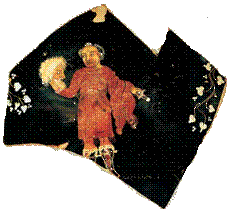
To get a better understanding of the Greek chorus, think back a few years to practicing Abraham Lincoln’s Gettysburg Address. Now picture you and your entire class reciting the address, with movement and gestures at the very same time. For one, it would be quite loud. (This might have been the birth of vocal amplification!) Also, it would be somewhat interesting to watch. Do you think the audience would get the point? Would they be entertained? Would they comprehend the material?
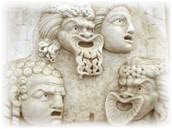 These may be the exact questions that came about in sixth century B.C.E., when a Dionysian priest walked out of the chorus and began to recite a monologue. A monologue is a speech performed by one actor which can be presented on-stage, alone or in front of other actors. The person that made this triumphant step was named Thespis, becoming the first actor and playwright to create and perform what were called tragedies. He is still honored today by referring to actors as “Thespians”.
These may be the exact questions that came about in sixth century B.C.E., when a Dionysian priest walked out of the chorus and began to recite a monologue. A monologue is a speech performed by one actor which can be presented on-stage, alone or in front of other actors. The person that made this triumphant step was named Thespis, becoming the first actor and playwright to create and perform what were called tragedies. He is still honored today by referring to actors as “Thespians”.
This created a new form of Greek theatre, adding spoken dialogue to the Greek chorus. Theatre became so popular that the first theatre was built in the honor of Dionysus. The Theatre Dionysus is most likely not only the first theatre in Greece, but perhaps in the whole world! This permanent space allowed for more performances and larger audiences. At that time, actors and audiences were mostly male since the plays were believed to be too tragic and upsetting for women.
In the spirit of Greek competition, performance competitions for Greek tragedies began and later became theatrical festivals adding comedy and satyr. These festivals are said to be the birthplace of the masks “Comedy and Tragedy”, so frequently associated with theatre of any kind.
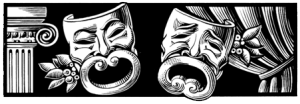
 Now answer questions 6 through 12.
Now answer questions 6 through 12.
4. Close-Up
Take a close-up look at theatre in Ancient Greece. You will view a video, images and interactive activities to help gain a better understanding of this moment in time, which was so instrumental to what we know today as theatre.
Click on the following link to watch a short video and get a closer look at Theatre in Ancient Greece.
![]() The Theater in Ancient Greece [01:26]
The Theater in Ancient Greece [01:26]
Take a look at the following images. The first is a detailed map of the Acropolis in Athens Greece in the Fifth and Sixth Centuries. Can you find the Theatre Dionysus?
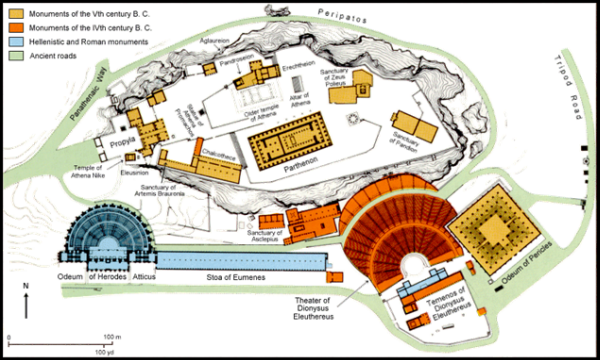
This next picture is a modern-day view of the Theatre Dionysus, still standing where it was built over 2,500 years ago.
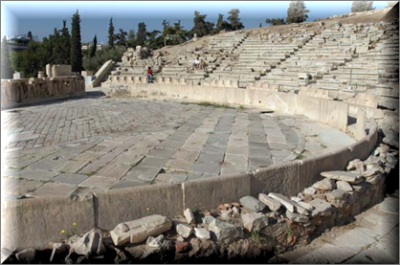
Although we will further study theatre spaces or stages later in this course, take a look at the sketch below of a Greek theatre. Think about what you have learned about Greek theatre. Notice each area and determine what purpose that area might have. Does this sketch look anything like a theatre that you have seen? What are the similarities and differences?
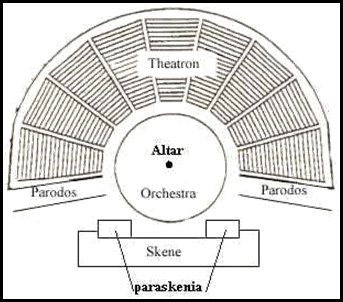
 Now answer question 13.
Now answer question 13.
5. Theatre throughout History
As we learned in the previous section, we do not know an exact date for the creation of theatre. However, we do know that there are dates throughout history, which are extremely significant to the development of what we know as theatre. Take a look at this abbreviated timeline, showing merely four periods, highlighting some of the great strides in the development of theatre. We could spend an entire course discussing the significance of each, but since we have limited time, we will focus on a small portion throughout this course, examining their influence on theatre today.

In this unit, we have begun to map out and will continue to focus on what is believed to be the beginning of theatre. In the following units, we will further this journey and gather a better understanding and appreciation for performance as one might see on the stage today.
 Now answer questions 14 through 17.
Now answer questions 14 through 17.
6. Art and Theatre
Theatre is an art form. However, unlike a novel, a painting or sculpture, theatre is a transitory art. What this means it that theatre is in constant transition. Every performance changes from minute to minute. Dance, music concerts, stand-up comedy or any other performing arts share this with theatre. Once a piece of art, whether a book or an etching, leaves the artist’s hands, it is complete. However, in theatre, the script is merely one aspect; as are the performers, costumes, props, etc. that are all components creating the art form. Read the following quote by author Bernard Beckerman, in his book Dynamics of Drama: Theory and Method of Analysis, with his explanation.
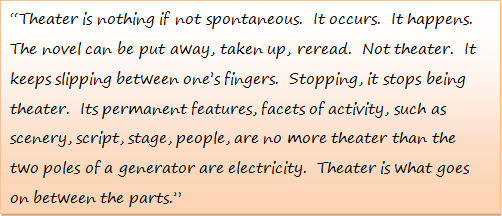
That being said, theatre also has another component that other art forms do not; an audience. This makes theatre, and other performing arts, a shared experience, including those who perform and those who observe. This only contributes to the ever-changing or transitory quality of theatre.
Later in this course you will take a closer look at the role of the audience in theatre. However, be certain that with action (actors), there is reaction (audience). These two groups of people communicate in a way that makes theatre the wonderful experience that it is. Now answer questions 18 and 19.
Now answer questions 18 and 19.
7. Terms and Concepts
Introduction
to Theatre I U01
|
|
altar |
Place for religious ceremony or to honor the gods. |
chorus
|
In ancient Greek drama, a group of performers who sang and danced, sometimes participating in the action but usually just commenting on it. |
comedy |
Dramatic form, broad in range, typically with a happy ending, light in tone, concerned with non-serious issues and designed to amuse and provoke laughter. |
Dionysus |
A god of joyful and intense emotions; he is associated with wine and wild behavior. Dionysus was the son of the chief god, Zeus, but his mother, Semele, was human. |
mask |
Covering for the face or part of the face, to conceal or disguise the identity. |
monologue |
Speech or dramatic sketch performed by one actor. |
orchestra |
Semicircular space in front of the stage used by the chorus.
|
parados
|
Space between the skene and audience, where the chorus entered. |
paraskenia |
Side-wings of the skene.
|
satyr play |
A comic play of ancient Greece burlesquing a mythological subject and having a chorus representing satyrs (a woodland spirit with horse’s tail and ears). |
skene |
Building behind stage to house actors, props and costumes. |
theatre |
Dramatic representation as an art or profession. |
theatron |
Area of seating, in a semi-circular shape with rows of seats rising up the slope. |
| thespian | Actor, from the tradition that Thespis was the first actor. |
| tragedy | Dramatic form which involves a serious action of universal significance and important moral and philosophical implications. |
Click on the following link for a printable version of this unit’s terms and concepts. TERMS
 Now answer questions 20 through 26.
Now answer questions 20 through 26.
8. In the Spotlight
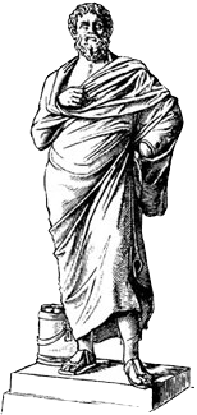 In this unit, we have discussed the importance of theatre in Ancient Greece and the role that it had in what we know as present day theatre. The early dramatists, including some works still presented today, truly paved the way for future generations. For this assignment, you will focus on one important dramatist from this time, Sophocles.
In this unit, we have discussed the importance of theatre in Ancient Greece and the role that it had in what we know as present day theatre. The early dramatists, including some works still presented today, truly paved the way for future generations. For this assignment, you will focus on one important dramatist from this time, Sophocles.
Sophocles (c. 496-406 B.C.E.)
Sophocles is known for plot construction, poetry, exploration of character, and focus on one individual. He also acted in his early plays and won his first dramatic contest in 468 B.C.E., beating fellow dramatist, Aeschylus. Sophocles was very popular during his lifetime; he won multiple drama contests, and never came in lower than second place. Sophocles made many changes in dramatic structure. He discarded the trilogy; writing single plays. He increased the size of the chorus from twelve to fifteen; changing their on-stage function to transitions separating the action.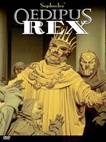
However, his most significant contribution to theatre is that he added a third actor; giving himself more dramatic flexibility and enabling more characters to be introduced, further challenging the protagonist and demonstrating the bearing tragedy has on more than one life.
Of his more than 100 tragedies, the most influential word is Oedipus Tyrannos, or better known as Oedipus Rex, which to this day still ranks as one of the world’s best tragedies. It is comparable to Hamlet, by William Shakespeare, which came many years later. Only seven of over 120 tragedies still exist today.
 Now answer questions 27 through 30.
Now answer questions 27 through 30.
 |
| Unit 1 The Origins of Theatre Matching |
| Unit 1 The Origins of Theatre Advanced Organizer |
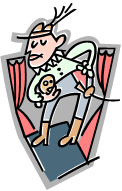
End of Unit 01.

